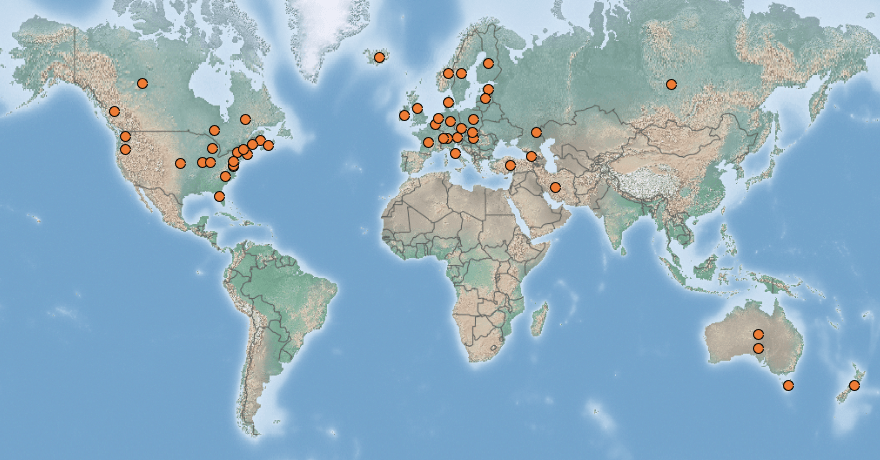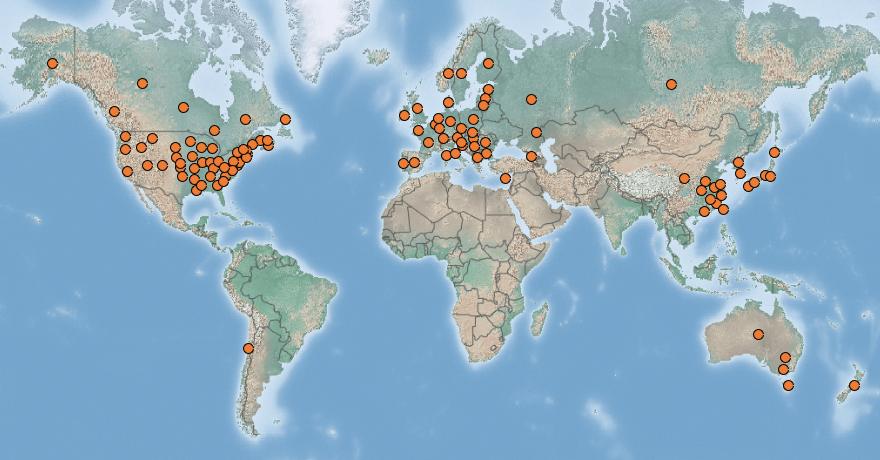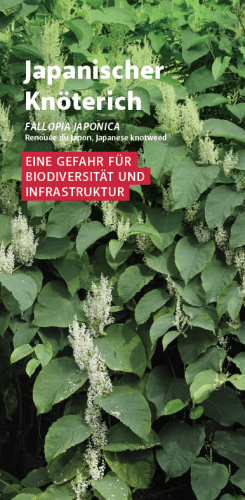 |
Giant hogweed | Status LU: established. 1st record: LU ~1934, ITW 1980. |
 |
Rise-Biereklo | Status Eur.: established. 1st record: UK 1817. IAS of EU concern (2017). |
 |
Berce du Caucase, berce de Mantegazzi | RA: ISEIA: A3, Black List. Harmonia+: 0,64. |
 |
Riesen-Bärenklau, Herkulesstaude | Wikipedia:     | Wikispecies: | Wikispecies:  | CABI | CABI |
 |
Reuzenberenklauw, Perzische berenklauw | Back to the list of neophytes |
Contents
Brief description
Heracleum mantegazzianum Somm. et Lev. inhabits moist and nutrient-rich soils in ruderal places, along roadsides, riverbanks and forest margins, in abandoned or neglected grasslands and in tall-herb communities. It is poorly represented in old successional stages but can occur in open alluvial forests. It usually invades sites with a low management intensity. Seeds are usually dispersed in the vicinity of mother plants except when growing near rivers. In that case, they may be transported over several kilometres.
The enormous height and leaf area of the giant hogweed enable it to overtop most indigenous herbaceous plant species typical of early stages of natural successions. It may form dense populations that absorb up to 80% of the incoming light and out-compete most light-demanding species. However, its abundance decreases in old successional stages due to competition with trees. Besides the ecological problems, tall invasive hogweed species also represent a serious health hazard for humans. The plant exudes a clear watery sap, which contains several photosensitising furanocoumarins. Upon contact with human skin and in combination with ultraviolet radiation, these compounds cause severe burning of the skin (Branquart et al. 2010).
IAS of Union concern
In 2017, Heracleum mantegazzianum Somm. et Lev. was added to the list of invasive alien species of Union concern (Anonymous 2017) which implies that member states shall take all necessary steps to prevent it’s unintentional introduction or spread.
Status and distribution in Luxembourg
Records of Heracleum mantegazzianum Somm. et Lev. in Luxembourg. Data source: Recorder-Lux, iNaturalist & GBIF, 2025-12-04.
The south-west Asian species was first documented in 1980 near Garnich by Léopold Reichling (1921-2009): “A colony of about a hundred feet is known to be located N of the Luxembourg-Arlon railway line east of the Garnich-Windhof road. Recent road works have reduced its importance.” (Reichling 1990: 62; MNHNL 2000-). Cultivated for ornamental use in parks and gardens. Subspontaneous or naturalized, quite rare, mostly widespread in urban areas and along highways; often abundant in its stations. Introduced in Brussels in the 1930s, this species has experienced, especially since the 1980s, a strong expansion in the Flora territory, as in other regions of Europe (Lambinon & Verloove 2012: 524).
Giant hogweed was getting very common and widespread in Luxembourg during the period 2000-2010. It generally occurred in small clusters along river banks, several major rivers of Luxembourg having been affected. Sometimes the species formed dense stands along rivers, bicycle ways and rail roads or on waste land. Since 2008 many stakeholders are involved in control measures resulting in the decline of the species. This might result in the downgrade of the ISEIA-code of the species (A3) in future risk assessments.
End of 2023, 560 records of this melliferous species were listed in the MNHNL-mdata online portal (MNHNL, iNaturalist & GBIF 2019). As is the case for many species, the shown map doesn’t reflect the actual status of the species, but its historical distribution accumulated in time.
Hybrids and other taxa
It is known that Heracleum mantegazzianum can hybridise with H. sphondylium (Heracleum mantegazzianum Somm. and Lev. × H. sphondylium L. var. dissectum Le Gall).
In Luxembourg, the hybrid has so far been detected 3 times in the north of the country: Harlange in 2014 (Krippel & Colling 2016: 37), Kuborn in 2016 (Krippel et al. 2018: 64), and Nothum in 2018 (Krippel et al. 2020: 39).
Other taxa that are more or less neighbouring are also sometimes cultivated for ornamental purposes. Thus, the subspontaneous state of Heracleum laciniatum Hornem. (Syn. Heracleum giganteum Hort.) has been reported in the territory of the Flora, but it has been hypothesized that they would actually be hybrids of Heracleum mantegazzianum × sphondylium. The taxonomy of large Asian Heracleum species introduced into Europe should be re-examined (Lambinon & Verloove 2012: 524).
Management
Since 2008, the Luxembourg Water Management Authority is systematically controlling giant hogweed on the river banks of the major rivers of Luxembourg and is running special units for this purpose.
The Upper-Sûre Nature Park in the north-west of Luxembourg (Ardennes) runs a monitoring and management plan on giant hogweed since 2009 in the frame of the national action plan “Heracleum mantegazzianum” (Krippel & Richarz 2013). The inventories show a prevalence of H. mantegazzianum populations in two valleys i.e. Harelerbaach and Dirbech, where the plants are growing predominately on riversides and alluvial meadows. Since 2009, the management plan is annually reviewed and consequently executed in the Upper-Sûre region. Giant hogweed is controlled by root cutting and, in the case of flowering plants, by umbel removal. These simple mechanical methods give excellent results, but have to be continued for several years, until the soil seed bank is depleted, especially in the valleys of the Surbich and Harelerbaach (Krippel & Colling 2014, 2016; Krippel et al. 2018: 64). At Tutschemillen, this invasive exotic species remains despite its regular elimination by the services of the Haute-Sûre Nature Park (Krippel et al. 2020: 39).
Since 2009, after a sensitisation campaign by the Nature and Forest Agency, several foresters systematically control giant hogweed in their areas.
Since 2010, the city of Luxembourg systematically controls hogweed on its grounds, especially along the Alzette river.
In 2012, three workers of the national railway company CFL were burned by giant hogweed while cleaning up an overgrown area of a railway station. A survey of several neophyte species on the national railway network (Pfeiffenschneider et al. 2014d) resulted in four sites identified with Heracleum, which were subsequently controlled in the same year.
Action plan
An action plan regarding Giant Hogweed has been published in 2020:
→ Finalised Action Plan for Heracleum mantegazzianum (Pfeiffenschneider & Hoppe 2020)
Giant hogweed auger
 In order to facilitate the control, an auger was developed by a Dutch company (https://www.eijkelkamp.com). The giant hogweed auger removes the roots of the giant hogweed ergonomically and effectively, preventing the plant from germinating again. For effective control, it is advisable to remove the roots from the non-flowering specimens both in the spring before flowering and in the autumn. The auger body is 33 cm long, with a diameter of 89 mm. The one-piece auger has a total length of 111.4 cm. The auger is easily emptied using a bent spatula.
In order to facilitate the control, an auger was developed by a Dutch company (https://www.eijkelkamp.com). The giant hogweed auger removes the roots of the giant hogweed ergonomically and effectively, preventing the plant from germinating again. For effective control, it is advisable to remove the roots from the non-flowering specimens both in the spring before flowering and in the autumn. The auger body is 33 cm long, with a diameter of 89 mm. The one-piece auger has a total length of 111.4 cm. The auger is easily emptied using a bent spatula.
Burn cases in Luxembourg
The Department of Ecology of the National Museum of Natural History made two surveys among physicians in Luxembourg on burns caused in 2008 and in 2011 and 2012 (cf. Ries et al. 2013). Results showed that there have been at least 60 cases of burns in 2011 and 2012, while the previous survey back in 2008 resulted in no feedback on burn cases. These features are in line with the ongoing spread of the species in that period in Luxembourg. Most victims were aged between 18 and 60 and have been affected by burns in summer. The severity of burns ranged from not severe to medium.
Special observations:
- When controlling giant hogweed during full flowering, the dust generated during removal of the flowers can penetrate between the protective clothing and the throat of a worker and cause a line or strip of burned skin (Adm. de la gestion de l’eau, personal communication, 2013).
- In 2013, children suffered burns when playing with the previous year’s withered stems in early spring (Danièle Dammé, personal communication, May 20, 2014).
Useful documents
- National sensitisation campaign in Luxembourg in 2014:
– Flyer in French and German [pdf 1,7 MB]
– Poster in French and German [pdf 1 MB] - Basic information poster about giant hogweed (English, Deutsch, Français, Nederlands) [jpg 3,5 MB]
- The giant hogweed Best Practice Manual (English, Deutsch, Français) [pdf 2,5 MB]
Risk assessment
ISEIA protocol
A3 (3+3+2+3) = Black List (Ries et al. 2013: 18).
Harmonia+ protocol
Overall risk score 0,64 = (Overall Invasion score 0,77 x Overall Impact score 0,83) (Ries et al. 2020).
 Invasion
Invasion0,83

 Impact
Impact0,64

 Risk
RiskWorldwide distribution
Bibliography
- Albers, M., S. Kohn, J. Steng & M. Pfeiffenschneider, 2001. Problematik der Bioinvasion. Kartierung von Japan-Knöterich, Riesenbärenklau und Indischem Springkraut an Woltz, Clerve und Wiltz. Ergebnisse der Kartierung. Studie des Büros ERSA im Auftrag von: Administration des eaux & forêts, arrondissement nord. August 2001. 7S. + Anhang.
- Anonymous, 2017. Commission implementing regulation (EU) 2017/1263 of 12 July 2017 updating the list of invasive alien species of Union concern established by Implementing Regulation (EU) 2016/1141 pursuant to Regulation (EU) No 1143/2014 of the European Parliament and of the Council. Official Journal of the European Union L 182: 37-39 (13.7.2017).
- Branquart, E., S. Vanderhoeven, W. Van Landuyt, F. Van Rossum, F. Verloove & A. Vervoort, 2010. Harmonia database: Heracleum mantegazzianum Somm. et Lev.. Harmonia version 1.2, Belgian Forum on Invasive Species. URL: http://ias.biodiversity.be [accessed on 2019-10-11]
- CABI, 2019. Heracleum mantegazzianum. In: Invasive Species Compendium. Wallingford, UK: CAB International. URL: www.cabi.org/isc [accessed 2020-03-02]
- Glesener, B., M. Pfeiffenschneider & C. Ries, 2009. Die Verbreitung von Impatiens glandulifera, Fallopia japonica, F. sachalinensis, F. ×bohemica und Heracleum mantegazzianum entlang der Hauptfließgewässer Luxemburgs. Bull. Soc. Nat. luxemb. 110 : 69-73. (pdf)
- Krippel, Y. & F. Richarz, 2013. Verbreitung und Management von Heracleum mantegazzianum Somm. et Lev. (Apiaceae, Spermatophyta) in der Obersauerregion in Luxemburg. Bull. Soc. Nat. luxemb. 114: 3-13. (pdf)
-
Krippel, Y. & G. Colling, 2014. Notes floristiques. Observations faites au Luxembourg (2012-2013). Bull. Soc. Nat. luxemb. 115: 109-124.
-
Krippel, Y. & G. Colling, 2016. Notes floristiques. Observations faites au Luxembourg (2014-2015). Bull. Soc. Nat. luxemb. 118: 27-51. [PDF 1.33 MB]
- Krippel, Y., T. Helminger & G. Colling, 2018. Notes floristiques. Observations faites au Luxembourg (2016-2017). Bull. Soc. Nat. luxemb. 120: 57-76. [PDF 265 KB]
- Krippel, Y., T. Helminger & G. Colling, 2020. Notes floristiques. Observations faites au Luxembourg (2018-2019). Bulletin Soc. Nat. luxemb. 122 : 29-55. [PDF 132 KB]
- Lambinon J. & F. Verloove, 2012. Nouvelle flore de la Belgique, du grand-duché de Luxembourg, du Nord de la France et des régions voisines. Sixième édition. Avec la collaboration de L. Delvosalle, B. Toussaint, D. Geerinck, I. Hoste, F. Van Rossum, B. Cornier, R. Schumacker, A. Vanderpoorten et H. Vannerom. Jardin botanique national de Belgique, Meise. CXXXIX + 1195 pp. ISBN : 9789072619884.
- MNHNL, 2000-. Heracleum mantegazzianum Somm. et Lev. in Recorder-Lux, database on the natural heritage of the Grand Duchy of Luxembourg. Musée national d’histoire naturelle, Luxembourg. URL: https://mdata.mnhn.lu [Accessed 2019-10-11]
- MNHNL, iNaturalist & GBIF, 2019. Heracleum mantegazzianum Somm. et Lev. in MNHNL-mdata, online portal combining species observation from Recorder-Lux, iNaturalist and GBIF. National Museum of Natural History, Luxembourg. URL: https://mdata.mnhn.lu [Accessed 2019-10-11]
- Pfeiffenschneider, M., 2001. Problematik der Bioinvasion. Nationales Inventar von Riesenbärenklau, Indischem Springkraut und exotischen Knötericharten. Ergebnisse einer Umfrage und Konzept zur Bekämpfung der Riesenbärenklaubestände. Studie des Büros ERSA im Auftrag von: Administration des eaux & forêts, Service de la conservation de la nature, November 2001. 23 S. + Anhang, Luxembourg.
- Pfeiffenschneider, M., 2007. Über die Verbreitung von Heracleum mantegazzianum, Impatiens glandulifera, Fallopia japonica und F. sachalinensis entlang der Gewässer Obersauer, Woltz, Clerve, Wiltz und ihrer Nebengewässer (Luxemburg). Bull. Soc. Nat. luxemb. 108 : 7-10. (pdf)
- Pfeiffenschneider, M., 2008. Neophyten in Luxemburg – Projekt Bioinvasion 2007. Arbeitsbericht. 18 S. (pdf)
- Pfeiffenschneider, M. & F. Hoppe, 2020. Plan d’action pour espèces exotiques envahissantes au Grand-Duché de Luxembourg : Berce géante, Heracleum mantegazzianum Sommier & Levier 1895. Version du 2020-09-23. Administration de la nature et des forêts, Luxembourg. 20 pp
- Pfeiffenschneider, M., P. Gräser & C. Ries, 2014a. Distribution of selected neophytes along the main rivers of Luxembourg. Poster in 2 parts at XXXIe réunion annuelle des collaborateurs scientifiques du Musée national d’histoire naturelle Luxembourg, 15.03.2014. (pdf 2,7 MB)
- Pfeiffenschneider, M., P. Gräser & C. Ries, 2014b. Distribution of selected neophytes along the national railway network of Luxembourg. Poster at XXXIe réunion annuelle des collaborateurs scientifiques du Musée national d’histoire naturelle Luxembourg, 15.03.2014. (pdf 1,4 MB)
- Pfeiffenschneider, M., P. Gräser & C. Ries, 2014c. Distribution of selected neophytes along the main rivers of Luxembourg. Bull. Soc. Nat. luxemb. 115: 101-108. [PDF 3668 KB]
- Pfeiffenschneider, M., P. Gräser & C. Ries, 2014d. Distribution of selected neophytes along the national railway network of Luxembourg. Bull. Soc. Nat. luxemb. 115: 95-100. [PDF 1457 KB]
- Pfeiffenschneider, M. & M. Owaller, 2000. Kartierung von Japan-Knöterich, Riesenbärenklau und Indischem Springkraut an der Obersauer. Theoretische Grundlagen und Ergebnisse der Kartierung. Studie des Büros ERSA im Auftrag von: Administration des eaux & forêts, acrrondissement nord. August 2000. 37S. + Anhang, Luxembourg.
- Reichling, L., 1990. Observations floristiques au Luxembourg 1980-1989. Bulletin de la Société des naturalistes luxembourgeois 90: 55-70. [PDF 808 KB]
- Reichling, L., 2008. Personal communication to C. Ries.
- Ries, C. & Y. Krippel, 2021. First records of 56 invasive alien vascular plants in Luxembourg. Bulletin de la Société des naturalistes luxembourgeois 123: 115-127. [PDF 241 KB]
- Ries, C., Y. Krippel, M. Pfeiffenschneider & S. Schneider, 2013. Environmental impact assessment and black, watch and alert list classification after the ISEIA Protocol of non-native vascular plant species in Luxembourg. Bull. Soc. Nat. luxemb. 114: 15-21. [PDF 652 KB]
- Ries, C., Y. Krippel & M. Pfeiffenschneider, 2020. Risk assessment after the Harmonia+ protocol of invasive alien vascular plant species in Luxembourg. Bull. Soc. Nat. luxemb. 122: 197-205. [PDF 132 KB]
- Ries, C, Y. Steil & M. Pfeiffenschneider, 2013. Survey amongst physicians in Luxembourg on burns caused in 2011 and 2012 by the giant hogweed (Heracleum mantegazzianum SOMMIER & LEVIER, Apiaceae). Poster at XXXe réunion annuelle des collaborateurs scientifiques du Musée national d’histoire naturelle Luxembourg, 16.03.2013. (pdf 1,2 MB)
Page content last updated on 2024-07-31. Last proofread by Caroline Grounds on 2019-11-11.












